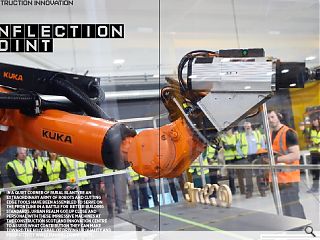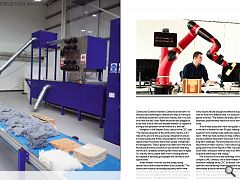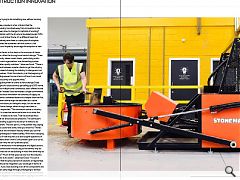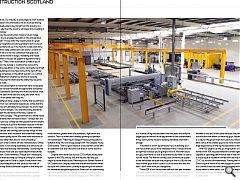Construction Innovation: Inflection Point
27 Jul 2018
In a quiet corner of rural Blantyre an extraordinary army of robots and cutting edge tools have been assembled to serve on the frontline in a battle for better building standards. Urban Realm got up close and personal with these impressive machines at the Construction Scotland Innovation Centre to assess what contribution they can make toward the holy grail of driving up quality and productivity while pushing down costs.
Construction Scotland Innovation Centre has a bold remit - to introduce new technologies, materials and ways of working to a notoriously recalcitrant construction industry. But is it a case of too little too late? Urban Realm toured the tech playground to see what it has to offer and evaluate whether it is capable of arming a new generation on the frontline of a ‘skills war’.
Evangelist in chief Stephen Good, director of the CSIC, said: “The majority perception of the construction industry is of a male on the end of a shovel, pursuing a wheelbarrow around a muddy building site. If that is the perception it limits the real opportunities this industry has to reach people of all genders and backgrounds. There is going to be a skills war in the future. My kids are at primary school and if you ask them what they want to do it’s probably something that involves tech or digital. Our industry has to present itself in terms of being relevant and capable of attracting good people who will have a lot of opportunities.”
Asked whether it was the case that simply raising salaries would have the desired effect Good countered: “The construction industry can actually pay pretty well for what you do. You might have to deal with the environment and the transitory nature of building sites but it’s not the worst paying industry out there. The salary part is not the limiting factor.” Is the industry flexible enough and attractive to people who want to move from different areas. Is it doing enough about gender diversity? “The statistics are pretty clear that it isn’t. It’s traditional, predominantly male and it has to work harder,” notes Good.
A lot of these issues aren’t new, having been on the radar in one form or another for over 30 years, feeding a degree of scepticism as to whether today really does represent a new dawn. What new tools are there to make a difference when previous initiatives have failed? Good said: “A lot of these are long-term challenges. The technology has now caught up with the promise of what it could do. There’s also a huge opportunity going back to the Simon Report of 1944, we’re great at writing down what’s wrong and what we need to do differently but not so good at delivering on that change.”
One of the first firms to take advantage of the new complex is JML Contracts, one of seven finalists in a timber innovation challenge set by CSIC. Its director, John Langley, is optimistic that the leasing model for expensive equipment will democratize access to the technology: “We’ve got our own factory and know the costs involved, especially with some of the kit that they’ve got there. It takes a lot of time and money to test new systems so we’re hoping that the innovation centre will help companies trying to do something new without running out of funding.”
Does Langley consider it a fair criticism that the construction industry has shied away from innovation in the past and has been slow to change its methods of working? That’s our frustration with the structural insulated panels (SIPs) that we use. It’s not timber frame, it’s a different beast but because it’s relatively new there is a slow pace of adoption. Smaller companies like ourselves can now come in, trial different things and hopefully encourage the adoption of new systems.”
A significant factor in this stasis is the omission of clients from the picture, often the driving force behind change. “There is a big opportunity where smart clients, particularly public-sector procurement organisations, are demanding quicker smarter and better-quality solutions,” observes Good. “There is now an alignment between smarter clients to get the industry they deserve instead of asking the industry to change and not changing themselves. I think this industry is at the beginning of a really interesting upward curve in terms of how it can invest and deliver productivity and opportunities.”
Highlighting the power of clients to force change Good cites the example of a local authority parcelling up a 500-home requirement into multiple small contractors, each offered to the cheapest bidder. Instead Good advocates a single commitment to the full 500 to boost innovation via certainty of supply, so that the final home is delivered faster and cheaper than the first.
The innovation centre might be described as a carrot encouraging the industry to change its ways, but do we also need a stick to force change, either through new laws or policies? Good responded: “The innovation centre is industry-led and driven. In a reactive sense we’re here to do what the industry thinks it needs to do next. That has evolved into a recognition that we should also be proactive. The carrot part I suppose is providing support to industry if it wants to do something different. The stick part is, in the politest way, saying ‘here’s what you could have done, have you tried this? There’s an environment at the innovation factory where you can trial ideas and test prototypes in relative safety. We’re not a lobbying organisation but if that requires us to ask tougher questions of industry and clients then I think it’s incumbent upon us to do so. There’s no reason why we can’t poke and prod.”
We’ve seen revolutions in the aerospace and digital sectors, why does the construction industry lag so far behind, why do we still see brickies out on site building in much the same way as in Roman times? “Much of that goes back to how the industry delivers solutions to its clients”, observed Good. “It’s such a broad industry that the procurement of solutions is fragmented. There is never the same integration you would get in terms of vertical supply. If you were building a car all the components are worked out at an early stage through prototyping to do their job and are then assembled in a smart way and delivered to the customer with a degree of confidence that it’s going to do what it’s supposed to do. Our industry is encouraged to work towards a cheapest solution wins and there is not as much partnering. If you were actually able to buy things from this industry in a smart enough way then the industry will respond by investing in R&D and technology.”
Is it fair to say the construction industry has an image problem, how do you engage the public on this and get back on the front foot? “Those within the industry think it’s great and it is hugely imaginative at solving problems but it’s one of those industries that ends up in the news for a bad news story, whether it’s a tram delay, parliament cost overrun, a block of flats that go on fire or a tier one contractor that goes bust.”
Britain leads the world in design, marketing and media but when it comes to houses we appear to lag behind many contemporaries? “That’s a fair observation to make if you’re looking at it from the outside in. Scotland has some of the toughest building regulations in the world, we already build high performance buildings and we have some of the best off-site manufacturing companies on the planet such as CCG, Carbon Dynamic and Robertson whether by volume or bespoke solutions but they need to showcase the ability they’ve got to achieve greater scale.
“It’s an obvious assumption to make that we’re not as good as others but we’ve been fortunate enough to take companies to Japan and Scandinavia Germany and Austria to look at what you perceive the best of the best are doing and often we’re doing as good if not better than they are.”
Striking a different tone Langley is mindful that we still have much to learn from our continental neighbours, noting that the current skills crisis will ultimately force change if we are to meet onerous construction targets. “Our overall building standards are nowhere near the standards of Norway, Sweden or Germany”, laments Langley. “The government as a whole needs to raise the standards that we need to reach.” I always liken it to buying a car. If you buy a cheap car that guzzles fuel and breaks down the next time you’ll go for a Mercedes because it will last longer and be cheaper to run. Our clients are more interested in energy efficiencies and running costs so they will go for the triple glazed windows, extra insulation and underfloor heating that makes a better quality house. We need more emphasis on the running costs rather than the unit costs of building.”
A consortium of ten Scottish off-site manufacturers, Offsite Solutions Scotland, is now being assembled as a vehicle to sell to the UK market and eventually internationally. Countering the perception that you must cast your eyes beyond these shores to find innovation. Good remarked: “People don’t necessarily know what’s on their doorstep so if they’re looking for a smart system they might look to China or Japan. If they knew it was here not only could they procure that product from the UK they could also help those businesses to grow so that they can export.”
Can Good foresee a point where every home is built to these standards? “It’s inevitable that the industry is going to move towards greater levels of automation, digitisation and robotics. That is a wheel that’s already spinning but perhaps not mainstream.” Referring to Glasgow Housing Association’s tentative foray into low energy design with The Glasgow House, Good added: “That’s a good idea but of course that comes with an additional cost and nine times out of ten it comes down to budgets.
Despite some advances such as CCG’s offsite closed panel system or the SIPs used by JML the industry has only just begun to tackle these issues. Referring to the Farmer Review of UK Construction Langley notes that telecommunications takes top spot with construction currently languishing at the bottom for innovation alongside agriculture. Given such an unpromising start how quickly can we scale up innovation by bringing the volume housebuilders on board? Langley said: “We’ve talked to a number of big housebuilders over the years and sadly the bigger guys at the end of the day answer to their shareholders. If they can build the house to building standards, then that’s enough.
“Innovation is driven by self-build. If you’re building your own house then you’re more interested in the U-values and the air tightness because you’re going to live in it. We often say to our guys look there is a cost to build the house, there’s a cost to run the house. The lifetime running costs of the house appeal to the self-builder because they’re going to live in it. But for the mass market guys once it’s sold it’s out the door and onto the next. I don’t know how you change that.
“I think 12% of our houses were self-built last year whereas in Austria it was 50-60%. If the big housebuilders decide that this is the standard they’re building to I reckon government is between a rock and a hard place because they need the houses built and are over reliant on these big guys. Hopefully the CS-IC is a way for the government to try and circumnavigate that and allow some of the smaller guys to be more innovative. There is a large dependency on the big housebuilders to deliver.”
With 160 projects on the go; ranging from a novel brick type formed from 95% recycled material to smart digital sensors capable of capturing performance data in real-time and even a unique type of insulation formed from old mop heads the CS-IC is a hot bed of inventiveness. Feeling like a big kid again Good is right at home in his new playground bristling with toys, but is mindful that solutions cannot be solely technological nor found within its walls alone - but will instead require a change of mindset amongst those still labouring away in the mud of the outside world.
|
|






